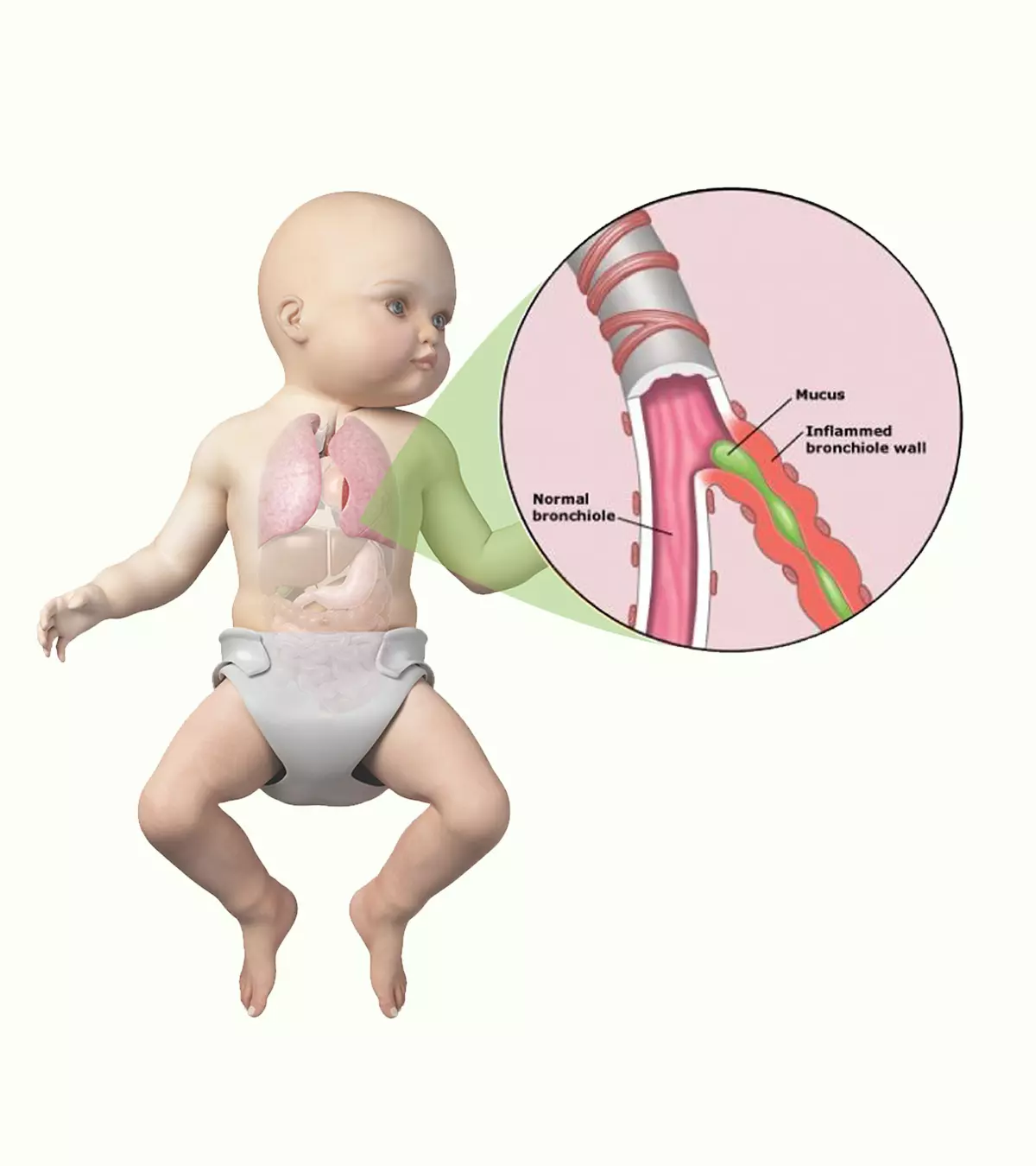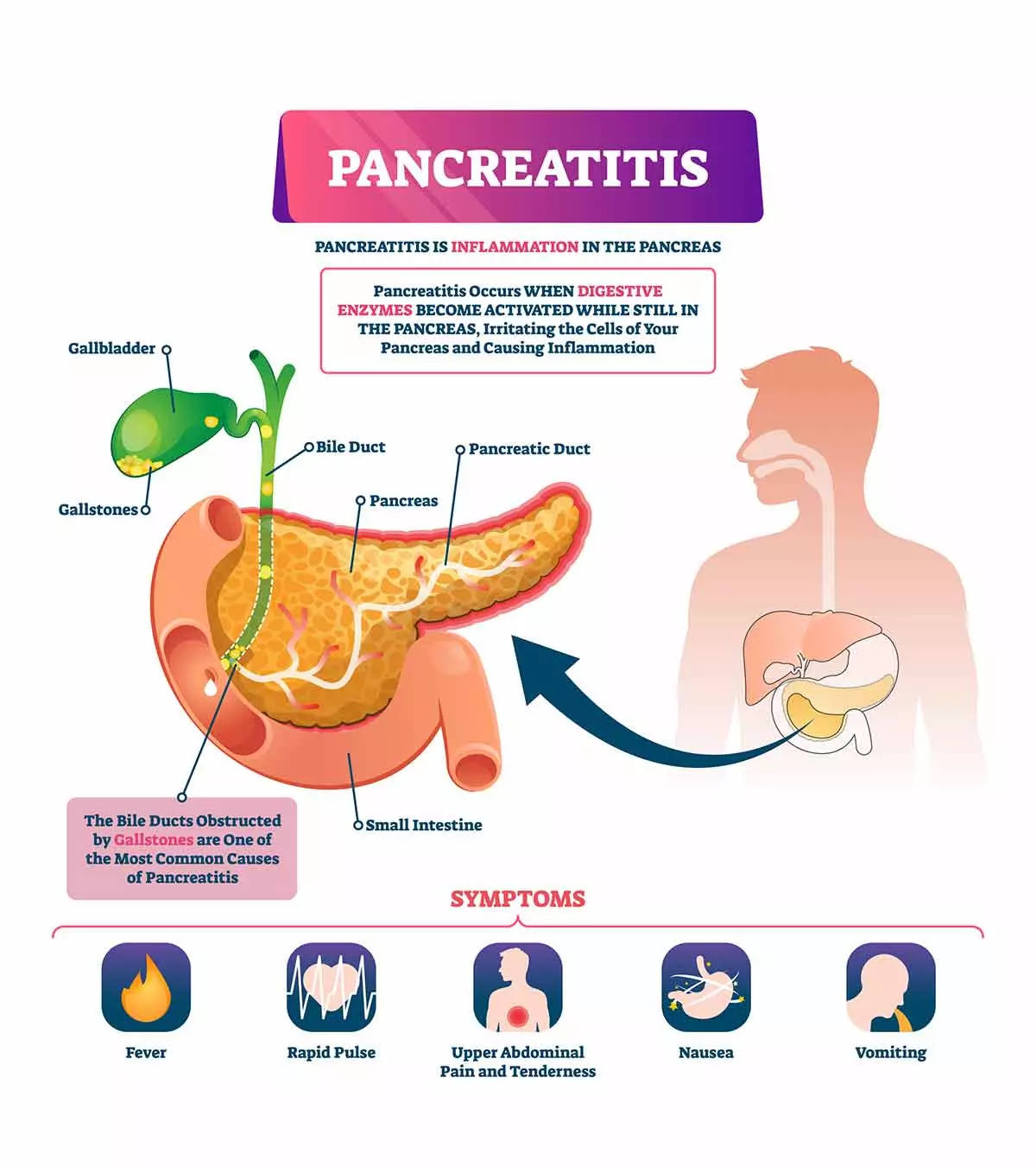

Image: Shutterstock
Biliary atresia in newborns is congenital. The condition is characterized by a blockage, damage, or abnormality in the bile duct, interfering with several liver functions. In addition, it may lead to other complications, including failure to grow and survive.

Read this post to learn about the causes, symptoms, treatment, prognosis, and prevention of biliary atresia in newborns.
What Is Biliary Atresia?
Biliary atresia is a condition where the bile duct of the liver is either blocked, damaged, or abnormally formed (1). The bile duct is a tube that starts as many fine ducts within the liver merging to create a common duct, which terminates at the small intestine. The gallbladder (storage pouch for excessive bile) intersects the bile duct in between.
The duct carries bile, a greenish liquid made by the liver to help the small intestine digest fats (2). Biliary atresia interferes with the flow of bile causing the fluid to accumulate within the liver, thus leading to liver damage. The disorder is either congenital or may develop shortly after birth. It only occurs in newborn babies.
What Are The Types Of Biliary Atresia?
One needs to know the parts of bile ducts to understand biliary atresia. The bile duct that goes from the liver up to the intersection of the gallbladder is called the common hepatic duct. The duct from the gallbladder till the small intestine is called the common bile duct. Bile ducts that stay within the liver are called intrahepatic bile ducts while those outside the liver are called extrahepatic bile ducts.
The following are the three types of biliary atresia that affect different parts of the bile duct (3):
- Type 1 or cystic biliary atresia: Only the common bile duct is affected. It accounts for about 5% of cases. Since it affects the bile ducts outside the liver, the condition is also called extrahepatic biliary atresia.
- Type 2: The common hepatic duct, along with some smaller ducts within the liver, is affected. It accounts for only 2% of cases.
- Type 3: Both the common hepatic duct and common bile duct are affected. It means the entire bile duct is either blocked or damaged. More than 90% of cases of biliary atresia are type 3.
Different factors can contribute to the development of different types of biliary atresia.
What Causes Biliary Atresia In Babies?
The exact cause of biliary atresia in infants is not known (4). The following are the probable causes, as cited by medical experts:
- Infections and exposure to chemicals: Catching a disease a few days or weeks after birth can cause the disorder. Examples of some pathogens linked to biliary atresia in babies are rotavirus, cytomegalovirus, and reovirus type 3. These viruses damage the bile duct and cause excessive scar tissue formation.
Exposure to toxins, chemicals, or certain drugs shortly after birth can also cause the problem. Infants who get biliary atresia due to infections and exposure to drugs/chemicals are born healthy and develop the disorder later. Biliary atresia that develops later is called perinatal biliary atresia and accounts for 65-90% of cases (5).
- Congenital problem: The bile ducts become deformed while the baby is still a fetus. Baby will have symptoms right at birth or shortly later. Congenital biliary atresia, also called embryonic/ fetal biliary atresia, is less common and only accounts for 10-35% of all cases. The condition can usually be diagnosed through a routine ultrasound during pregnancy.
- Genetic etiologies: Experts also note that problems with genes could cause autoimmune damage, wherein the immune system destroys the bile duct.
- Immunologic etiologies: Immune dysregulation, either as a primary disorder or as the result of infectious or genetic triggers, has been implicated in various studies.
Experts also note that problems with genes could cause autoimmune damage, wherein the immune system destroys the bile duct. Biliary atresia is not a genetic disease, which means the baby cannot inherit the disease from a parent.
How Common Is Biliary Atresia In Babies?
Biliary atresia is the most common cause of end-stage liver disease among infants and the leading cause for liver transplant among babies (6). It tends to be more common among females than males. The highest occurrence is among East Asians.
The rate of appearance in the United States is one in 10,000 to 15,000 births while in Europe it is one in 12,000 births. The worldwide prevalence is one among 8,000-18,000 births (1). Nearly 10-20% infants who have the condition also have other problems such as heart defects (7). Overall, biliary atresia is considered a rare neonatal liver disorder.
What Are The Symptoms Of Biliary Atresia In Babies?
Here are some of the symptoms of biliary atresia (8):
- Jaundice: It is the first and most notable symptom of biliary atresia. Symptoms include the yellowing of the skin and the white of the eyes. It occurs due to the buildup of bilirubin, the compound that the liver converts into bile. Jaundice among newborns, or physiological jaundice, is common and occurs because the newborn’s liver is still adjusting to normal functioning.
Physiological jaundice does not cause any problems and resolves within the two weeks (9). It is when jaundice goes beyond three weeks that it becomes an indicator of biliary atresia.
- Change in stool color: Stools of babies with biliary atresia can be pale yellow, gray, or even white.
- Dark-colored urine: Urine has a darker hue than usual.
- Swollen abdomen: Liver inflammation due to bile duct failure leads to a swollen abdomen.
- Irritability and poor growth: If biliary atresia persists for 6-10 weeks, you notice the first signs of complications such as poor weight & height gain, increase in blood pressure, and severe fussiness & irritability. The baby may feed normal quantities or probably more, but will still have problems growing since the body does not adequately absorb the breast milk.
Biliary atresia is a progressive disease and gets worse when ignored. The disease can cause collateral problems such as the accumulation of fluids in the belly and enlargement of the spleen.
A baby displays the biliary atresia symptoms immediately after birth or 2-6 weeks after birth. Those who develop biliary atresia due to an infection like rotavirus infection will experience the symptoms only after the illness develops. Biliary atresia, if neglected, can lead to some complications but a doctor can diagnose it soon after birth or during routine checkups.
How Is Biliary Atresia In Babies Diagnosed?
The doctor will recommend diagnostic procedures to detect biliary atresia if your baby has jaundice for more than three weeks. The following steps and procedures are necessary for an accurate diagnosis (10):
- Physical examination to check for the tell-tale signs of jaundice including yellowing of the skin and the white of the eyes. The doctor gently feels for any underlying swelling within the baby’s abdomen that could indicate problems with the liver.
- Blood test for liver functions to check for bile levels. High bilirubin levels in the blood indicate jaundice and a problematic liver function. High levels of liver enzymes also indicate a problem. The rate at which the blood clots is also checked to detect the presence of any pathogen in the blood. Liver function tests play a vital role in eliminating the possibility of other liver diseases like hepatitis.
- Urine and stool test: Excretions would contain the excessive bilirubin.
- Ultrasound: An ultrasound scan of the abdomen can help view anomalies of the liver and also rule out any other problems.
- Hepatobiliary scan: The body is injected with a small amount of safe radioactive substance. This substance reaches the liver and enters the bile duct. It then helps create a clear X-ray image of the bile duct and the liver for the doctor to assess.
- Liver biopsy: It may be seldom used for babies. However, if the baby has other problems or other tests are inconclusive, then the doctor may collect a sample of the liver for laboratory analysis
The doctor may run several other diagnostics like congenital heart defect tests to determine if the baby has other problems. Treatment begins soon after the diagnosis, if necessary.
How Is Biliary Atresia In Babies Treated?
There is no medicine to cure biliary atresia, but surgery can help bring down the intensity of the condition. The surgery aims at slowing the progression of the disease making it almost non-existent. The following are the surgical treatment methods for biliary atresia in babies. (11):
- Kasai procedure: The Kasai surgical procedure, also called Kasai hepatoportoenterostomy, was developed by the Japanese surgeon Dr. Morio Kasai. It involves complete removal of the bile duct. A part of the small intestine is rolled into a loop and connected to the liver to let the bile flow directly into the small intestine.
There could be variations in the procedure depending on the extent of liver damage and severity of biliary atresia. The operation has an 80% success rate when conducted among babies below the age of three months. But nearly 50% of infants develop an infection called cholangitis as a complication of the surgery.
Doctors will prescribe antibiotics and in severe cases give intravenous antibiotics to contain the infection. If the procedure is unsuccessful or infection too severe, then the only alternative treatment is a transplant.
- Liver transplant: Liver transplant is the last resort when the Kasai procedure is unsuccessful. A transplant is the only option in cases where the blockage is within the intrahepatic bile ducts or the bile ducts inside the liver.
Organ transplant is a complicated procedure involving counseling of the family, finding the right donor, the extent of organ requirement (partial or complete liver), and preparing for the operation. Most babies will require liver transplant eventually in life, usually by the age two years, even after a successful Kasai procedure due to persistent issues with the liver.
How Is Postoperative Management Done?
Medical care following Kasai hepatoportoenterostomy (HPE) consists of the following interventions:
- Choleretics
- Nutritional supplementation
- Fat-soluble vitamin supplementation
- Prevention of cholangitis
- Management of portal hypertension and its sequelae
The advancement in medicine has helped improve the chances of recovery. More than 90% of infants have an excellent success rate after any of the two treatment procedures. Managing the baby’s diet is a crucial step in post-operative care.
What Is The Prognosis Of Biliary Atresia After Treatment?
Your baby will require a specialized diet plan after the Kasai procedure when the amount of bile goes lower than normal or healthy levels. Low bile levels can cause problems with digesting fat, fat-soluble vitamins, and other related conditions such as faster metabolism with a need for more calories (12).
Therefore, the infant would need a special formula, and added supplements in the breast milk, formula, and other food to prevent malnourishment and ensure healthy growth.
Babies who have had a liver transplant can have the usual diet of breast milk and solid foods after the age of six months. They will, however, require long-term medications that prevent organ rejection and help the new liver integrate better with the new body. The exact steps of management vary from patient to patient. The baby’s surgeon will tell you precisely how to care for the baby post surgery.
A baby with a successful Kasai procedure will thrive well and in some cases may never need a liver transplant. Infants with liver transplant do well once the new liver correctly unifies with the body. Regardless, parents often wonder if there are ways to prevent the disorder.
Can You Prevent Biliary Atresia In Babies?
There is no way to prevent biliary atresia since there is no precise cause for the problem (13). Preventing infections early in life is probably a way to minimize the risk of biliary atresia. Avoiding some of the diseases is easy when you follow simple preventive steps such as good hygiene and only breastfeeding the baby for the first six months.
Immunization can be an option in some cases, such as the rotavirus vaccine for rotavirus infection. Nothing can be done in cases where the baby already has a blocked/damaged bile duct as a fetus.
Frequently Asked Questions
1. Can a baby survive with biliary atresia?
Yes, babies with biliary atresia can survive. Moreover, early diagnosis and treatment can increase the chances of survival (5).
2. How long can babies live with biliary atresia?
Although biliary atresia in newborns is a rare neonatal liver disorder, it is the most prevalent cause of end-stage liver disease and the most common cause for liver transplantation in infants. It can be classified into three types depending on which part of the bile duct is affected. Surgical techniques such as Kasai hepatoportoenterostomy or a liver transplant can delay disease progression and allow the infant to live a normal, healthy life. Although it cannot be prevented, avoiding certain diseases and infections in early life can minimize its risk.
Key Pointers
- Biliary atresia disrupts regular bile flow from the liver, causing liver damage.
- It could be caused by infections, exposure to chemicals, congenital problems, etc.
- The symptoms of biliary atresia in babies include jaundice, dark-colored urine, and poor growth.
- The condition can be managed with surgery, which slows down the disease progression.
References
1. Biliary Atresia; National Organization for Rare Disorders
2. Secretion of Bile and the Role of Bile Acids In Digestion; Colorado State University
3. Biliary Atresia; The University of Chicago
4. Biliary Atresia; Stanford’s Children Health
5. Biliary Atresia; Children’s Hospital of Philadelphia
6. Newborn Screening for Biliary Atresia; American Academy of Pediatrics
7. Biliary Atresia; American Liver Foundation
8. Symptoms & Causes of Biliary Atresia; National Institute of Diabetes and Digestive and Kidney Diseases
9. Newborn jaundice; U.S. National Library of Medicine
10. Diagnosis of Biliary Atresia; National Institute of Diabetes and Digestive and Kidney Diseases
11. Treatment for Biliary Atresia; National Institute of Diabetes and Digestive and Kidney Diseases
12. Eating, Diet, & Nutrition for Biliary Atresia; National Institute of Diabetes and Digestive and Kidney Diseases
13. A.M. Banc-Husu, Biliary Atresia; American Liver Foundation
14. Shikha S. Sundaram et al. (2017); Biliary Atresia: Indications and Timing of Liver Transplantation and Optimization of Pre-Transplant Care; NCBI
15. Masato Shinkai et al. (2009); Long-term outcome of children with biliary atresia who were not transplanted after the Kasai operation: >20-year experience at a children’s hospital; NCBI
Community Experiences
Join the conversation and become a part of our nurturing community! Share your stories, experiences, and insights to connect with fellow parents.
Read full bio of Dr. Atiqur Rahman Khan
Read full bio of Rohit Garoo
















